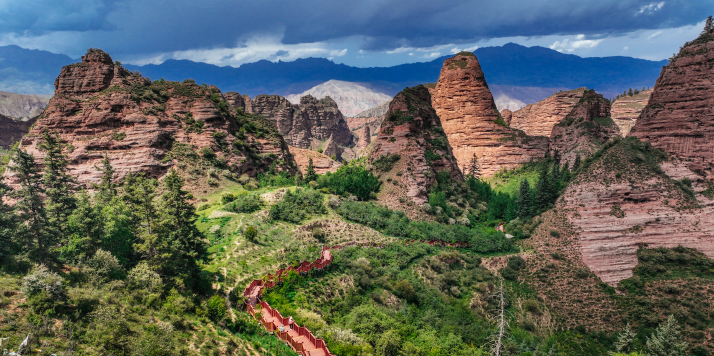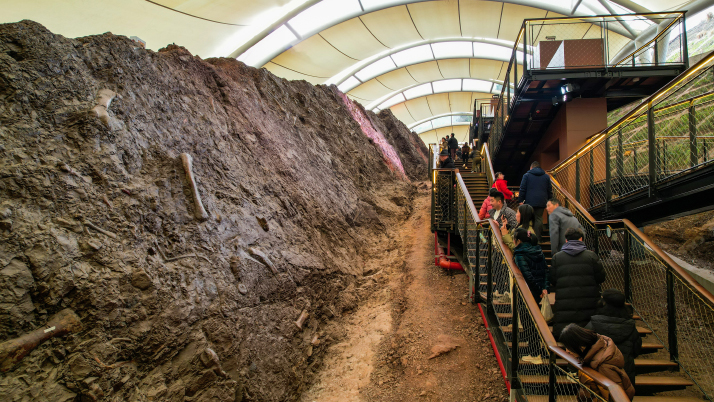| China |
| Two Chinese geoparks honored by UNESCO | |
|
|
 The Kanbula Geopark in Huangnan Tibetan Autonomous Prefecture in Qinghai Province on June 25, 2023 (XINHUA)
Two Chinese geoparks have been officially designated by the United Nations Educational, Scientific and Cultural Organization (UNESCO) as UNESCO Global Geoparks, the organization announced on April 17. This raises China's total number of UNESCO-recognized geoparks to a world-leading 49. The two geoparks are Kanbula Geopark in Huangnan Tibetan Autonomous Prefecture in Qinghai Province in northwest China and Yunyang Geopark in Chongqing Municipality in southwest China. The UNESCO Global Geoparks Network, established in 2015, recognizes sites with significant geological heritage that illuminates Earth's history, evolution and climate. During its 221st session, UNESCO's Executive Board approved the addition of 16 new sites to the Global Geoparks Network, bringing the total number to 229. UNESCO Director General Audrey Azoulay highlighted the broader significance of UNESCO Global Geoparks. "UNESCO Geoparks have become models for the conservation of geological heritage," she said. "But their role goes much further—they support educational projects, promote sustainable tourism, and keep the knowledge and traditions of these territories alive through the active participation of local and indigenous communities." Rare landscapes The Kanbula Geopark is renowned for its striking geological formations shaped by complex natural processes. Highlights include the Maixiu volcanoes and a section of the Yellow River, according to a UNESCO press release. "While the geopark works to preserve this rich geological heritage, it also plays a vital role in protecting local communities from river-related risks, coordinating warning systems and forecasts, and raising awareness on how to respond to flooding and landslides," UNESCO noted. Within the park, there are 157 geological relic sites, covering a wide range of features including volcanic landforms, landslide remnants and Danxia landforms. Danxia landforms are unique to China, resembling the country's limestone karst landforms, but made from red sandstone and conglomerate. They are characterized by spectacular red cliffs and a range of erosional landforms, including dramatic natural pillars, towers, ravines, valleys and waterfalls. The park also preserves stratigraphic structures from three geological periods, offering scientists a valuable window into tectonic movements. Billions of years of geological processes, combined with uniquely favorable geographical conditions, have created the Kanbula Geopark's breathtaking natural landscapes. The Yellow River, still a translucent jade-green in its upper reaches, reflects the vermilion-hued Danxia landforms. The Longwu River, a primary tributary of the Yellow River, carves precipitous canyons as it flows north to south through the park. Interspersed mountain deciduous broad-leaved forests and evergreen coniferous forests create a natural oxygen oasis on the Qinghai-Xizang Plateau. Rare and precious wildlife, such as Tibetan antelopes and white-lipped deer, roam along the banks of the Yellow River, adding to the wealth of biodiversity. "The blend of Danxia landforms with turquoise waters creates a landscape of exceptional rarity. This unique combination makes the Kanbula Geopark a coveted destination for geology enthusiasts," Pan Chiqing, Chairman of Qinghai Regong Culture Protection and Development Co. Ltd., told news portal Cnr.cn on April 15. The Kanbula Geopark is more than just a natural wonder; it's a tapestry woven with diverse cultures, where the vibrant Regong art flourishes. A crucial part of Tibetan Buddhist art in China, Regong art is a genre with wide-ranging influences. Originating from Tibetan culture in the early 15th century, Regong means "golden valley" in the Tibetan language. For centuries, generations of painters and artisans have drawn inspiration from the area's geological wonders, creating thangkas, murals and sculptures—collectively known as the Regong arts. Thangka, the art of painting religious scrolls used to venerate Buddha, involves applying natural dyes to cloth prepared with patterns sketched in charcoal, using a specialized brush. Within the park, Tibetan villages are scattered like stars. Those living there have thrived for generations, creating a unique folk culture. Visitors can experience the traditional Tibetan way of life firsthand: savoring fragrant butter tea (made from yak butter and tea leaves), enjoying refreshing highland barley wine, and witnessing passionate Tibetan song and dance performances. The park also partners with the Kanbula Township Nine-Year Compulsory Education School to foster geological literacy and ecological responsibility among local youth. Through activities like science knowledge contests and study tours, the geological science popularization school aims to ignite children's interest in geological science and cultivate their awareness of protecting geological resources. "We are increasing investment in the scenic area to improve infrastructure and we are committed to providing excellent services and support for tourists," Pan said. "This not only enhances visitors' experiences but also presents Kanbula's image to the world." To further enhance the visitor experience, Kanbula Geopark has upgraded 25 tour buses and 19 tour boats and constructed five wooden boardwalks that meander through the landscape, connecting various scenic spots.  The dinosaur fossil wall in the Yunyang Geopark in Chongqing Municipality on January 30 (XINHUA)
Dinosaur kingdom The Yunyang Geopark secured its UNESCO designation thanks to its extraordinary landscapes, formed nearly 250 million years ago. The park is home to the famous "Great Wall of Dinosaur Fossils"—an 18-km stretch of rock layers containing fossils dating back approximately 170 million years. Six new genera or species of dinosaurs have been identified within the park, including the Yunyangosaurus puanensis and the Yuzhoulong qurenensis. The geopark also features dramatic karst formations, including one of the world's deepest sinkholes, plunging 335 meters and serving as a major site for scientific research. The Yunyang Geopark possesses a unique and diverse ecosystem, where mountains and rivers intertwine amid lush vegetation. Its primeval forests and alpine meadows teem with flora and fauna, including 57 species of nationally protected plants and animals, such as the dawn redwood (Metasequoia glyptostroboides). Furthermore, the geopark preserves numerous historical sites and cultural heritage. For example, the Zhangfei Temple, initially built over 1,700 years ago to commemorate Zhang Fei, a renowned general of the Shu Kingdom during the Three Kingdoms Period (220-280), houses an extensive collection of steles, calligraphy and paintings dating back to the Han (202 B.C.-A.D. 220) and Tang (618-907) dynasties. Chen Daobin, Secretary of the Communist Party of China Yunyang County Committee, stated at an April 18 press conference in Beijing that Yunyang's UNESCO Global Geopark designation will attract more tourists, stimulating cultural tourism projects, creating jobs and enabling local residents to benefit from the growing tourism industry. Copyedited by G.P. Wilson Comments to jijing@cicgamericas.com |
|
||||||||||||||||||||||||||||
|